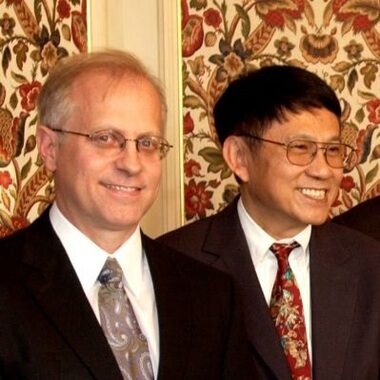R. Hemley: un profilo (inglese)
USA - USA/Cina
Russell Hemley e Ho-kwang Mao
Premio Balzan 2005 per la fisica dei minerali
Per il grande significato dei loro lavori congiunti che hanno portato a realizzare progressi fondamentali, sia a livello teorico che sperimentale, nel campo dei minerali sottoposti a condizioni fisiche estreme. Si sono sempre distinti come un team efficientissimo, caratterizzato da vent’anni di contributi alla ricerca di altissimo livello. Hanno sviluppato tecniche che hanno permesso di studiare il comportamento di una vasta gamma di materiali, come l’idrogeno, il “minerale” più abbondante nell’universo. I loro risultati hanno contribuito in modo fondamentale alla nostra comprensione della natura.
Russell J. Hemley’s research explores the behavior of materials over a broad range of thermodynamic conditions from low to very high pressures. He began his research career in molecular spectroscopy and electronic structure theory. An interest in the effects of high pressures on materials led him to the Geophysical Laboratory of the Carnegie Institution of Washington. There he began to apply and extend chemical physics techniques in high-pressure diamond anvil cell experiments. Since then, his research program has expanded to include high-pressure experimental and theoretical studies in condensed matter physics, earth and planetary science, and materials science. Some of his accomplishments include the discovery of new phenomena in dense hydrogen at megabar pressures; observations of unusual transformations in molecular materials and novel high-pressure molecular compounds; the creation of new superconductors, magnetic structures, glasses, and superhard materials under pressure, and the synthesis of single crystal diamond by chemical vapor deposition. He is also involved in the continued development of high-pressure techniques, including optical methods, synchrotron radiation for diffraction and spectroscopy, and transport measurements.
Russell J. Hemley grew up in California, Colorado, and Utah, and attended Wesleyan University, where he studied chemistry and philosophy (B.A., 1977). He did his graduate work in physical chemistry at Harvard University (M.A., 1980; Ph.D. 1983). After a post-doctoral fellowship in theoretical chemistry at Harvard (1983-84), he joined the Geophysical Laboratory as a Carnegie Fellow (1984-86) and Research Associate (1986-87), and became a Staff Scientist in 1987. He has been a visiting Professor at the Johns Hopkins University (1991-92) and at the Ecole Normale Superieure, Lyon (1996). He is the recipient of the 1990 Mineralogical Society of America Award, and is a Fellow of the American Physical Society, the American Geophysical Union, and the American Academy of Arts and Sciences. He was elected as a member of the National Academy of Sciences in 2001. He has authored on over 430 publications.
(September 2005)
